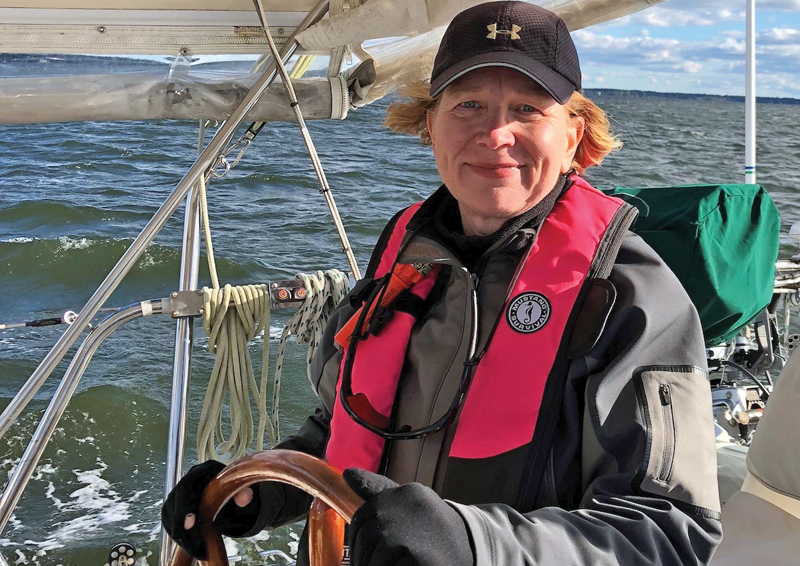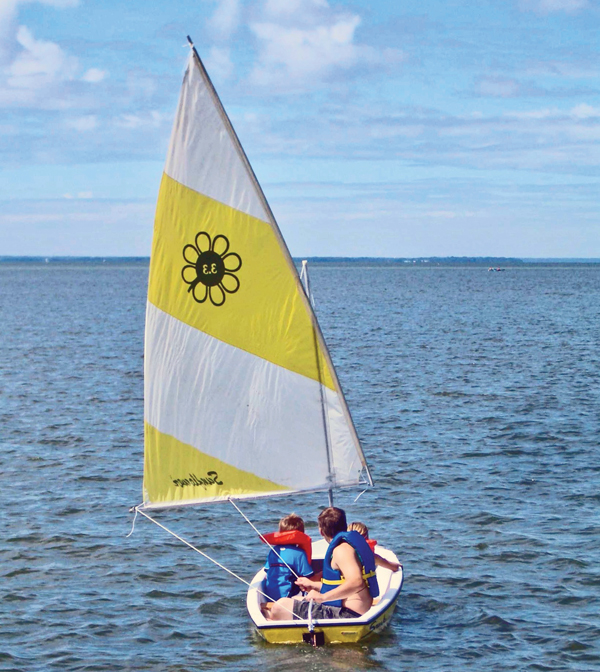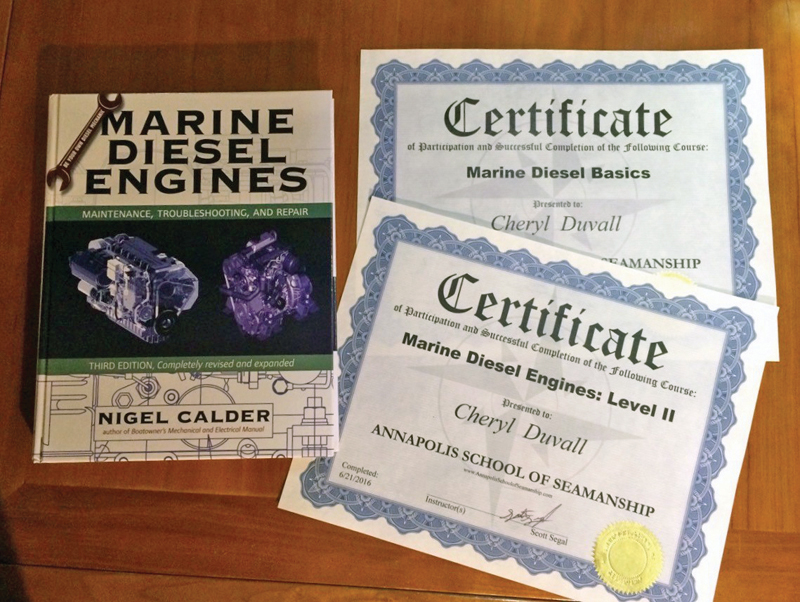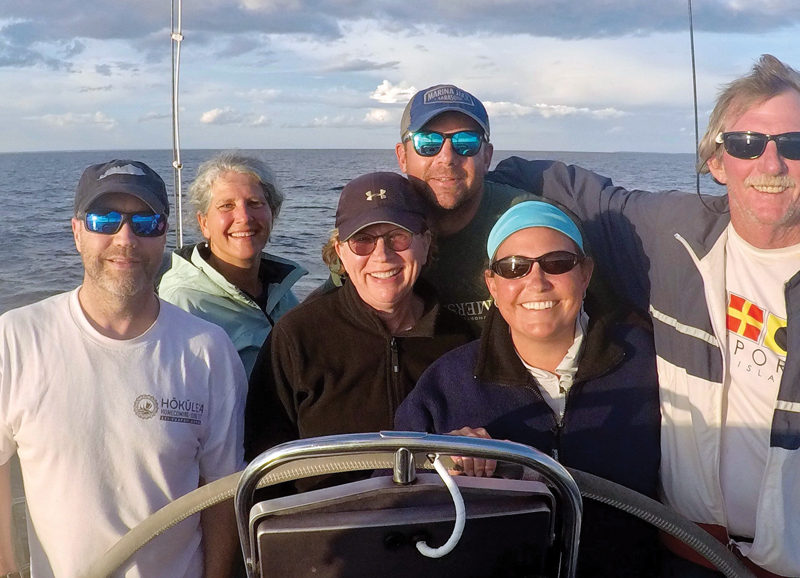Enamored with sailing since childhood
I’ve been enamored with sailing since the age of eight when my non-sailing dad bought an eleven-foot Snark from Sears Roebuck, made of unsinkable ABS polymer. I enthusiastically learned to sail that 50-pound daggerboard vessel in waters near our Baltimore County home. On vacations to Ocean City, we would carry that Snark on the roof of our Subaru station wagon to sail in Assawoman Bay. We often capsized when my 220-pound dad would tack or gybe and my sister and I couldn’t shift our bodies quickly enough. I discovered years later that the maximum capacity was 310 pounds and our combined weight easily exceeded that!

Three decades later I learned that Snarks were still in production, so I nostalgically bought one for my two young sons to learn to sail near our Hoopers Island vacation home. I kept that boat for 21 years and recently gave it away after a final swan song sail near Oxford, MD. I often advise people not to get snarky or sniff their noses at Snarks. Those boats can create a passion for sailing!

Keelboat sailing
As a young adult, I took a smattering of weekend sailing classes but lacked time to sail on a consistent basis until I joined the Downtown Sailing Center (DSC) in Baltimore. I worked nearby at the time, so found it convenient to attend open sails on Wednesday evenings and fun races on Friday evenings. I took Basic Keelboat lessons at the DSC and learned to sail their fleet of J/22s, Impulses, and Sonars. When my oldest son turned eight, he started five consecutive summers of weeklong DSC sailing camps while honing his skills on our Snark. Our family also began attending the Annapolis Sailboat Show where I dreamed that someday I would own and operate a larger sailboat.
When my sons entered high school and college, I finally made time to expand my sailing horizons. I took additional keelboat classes at J/World Annapolis and became a skipper at the DSC, which meant I could take out keelboats on my own. I made several lifelong friends at the DSC including my husband, Dudley Whitney, when we were set up on a blind date by two DSC sailors. At the time, Dudley co-chaired the DSC cruising program, overseeing a fleet of eight cruising boats. Six months later, he and I chartered a monohull in the British Virgin Islands (BVI), and I was hooked on larger boat sailing.
Cruising
After our first charter, we began to seriously consider cruising as a lifestyle goal. We joined the Seven Seas Cruising Association (SSCA), attended SSCA gams, took classes at Cruisers University, and chartered a four-cabin catamaran in the BVI for a family adventure. In 2010 we bought our first boat together, a Hunter 420 Passage. We named her Blind Date and were married on her by a DSC captain friend with family and matchmakers in attendance. We spent weekends that summer sailing to various Chesapeake towns, inviting friends to join us at 20 different ports of call. I also continued my education by taking US Sailing Bareboat and Basic Cruising courses with the Colgate Offshore Sailing School.
After sailing the Chesapeake for four years and redefining our cruising goals, we bought a 1997 Gozzard 44 and renamed her Belle Bateau. Following a refit at her birthplace in Goderich, Canada, we paused our careers for seven months and sailed to Fort Pierce, FL, and back, totaling more than 2000 miles along the Intracoastal Waterway and offshore. That cruising experience opened my eyes to what I did not know and what I wanted to learn. My husband had become a licensed captain before our “sailbatical,” after taking courses at the Annapolis School of Seamanship, and I was motivated to become his equal (or more).

Becoming a licensed captain
When we returned in the spring of 2016, I seriously committed to becoming a more knowledgeable sailor and a licensed captain. Lacking confidence with docking our 17-ton boat, I hired Captain Steve Maddox of SeaAffinity to instruct me on Belle Bateau, even though my patient husband and I could have practiced together. We agreed that Captain Steve would offer valuable insights, and we both trusted him. Thirty instructional hours later, after numerous ins and outs at our Baltimore marina slip in varying winds, I was proficient. Since then, I’ve been at the helm of Belle Bateau for every launching and docking, with Dudley or others handling the lines.
Concurrent with private instruction that summer, I completed several classes at Annapolis School of Seamanship including Marine Diesel Basics Levels I and II, Basic Navigation and Piloting, Navigation II, and Docking and Maneuvering. I also crewed offshore to Block Island with friends on their 44-foot Morgan, crossing busy New York shipping lanes at midnight.
One year later, with those experiences and another season of Chesapeake sailing behind me, I stumbled upon the Mariners Learning System (MLS) booth at the fall Annapolis Sailboat Show. Knowing that my learning style prefers slow and steady rather than a fire hose, I used the show discount and invested in MLS. I waited until New Year’s Day to pull the trigger on the online courses and successfully passed the captain’s exam on April 7. I was the only female in a room of 10 wanna-be captains. It took an additional five months to assemble all parts of the USCG license application, including 360 days of documented sea time, 90 of which had to be within the previous three years. By November 2018, I was a USCG Licensed Master, Inland 50 GRT.

Continuing to build experience
I continued to build my sailing experience with offshore passages, including sailing from Bermuda to Newport in 2019 with Captain Tania Aebi on a Swan 48. Other bluewater sails included the Exumas and an overnight passage from St. Maarten to the US Virgin Islands. In 2021 after enjoying a few charters in French canals, I took a Royal Yachting Association (RYA) training course, passed the CEVNI exam, and obtained my RYA International Certificate (ICC) for Inland Waterways, allowing me to drive pleasure barges up to 65 feet in most of Europe.
One of my most thrilling sailing adventures occurred last year when my husband and I completed 101 days at sea, from Annapolis to Maine and back. Before we departed, I submitted my captain’s license renewal application, including sea time as well as a renewal course certificate. The USCG increased my tonnage to less than 100 GRT on Inland Waters.
I continue to seek educational opportunities. Two years ago, I joined the Chesapeake Area Professional Captains Association (CAPCA) after reading about their monthly programs in SpinSheet. I was recently elected to a two-year term as CAPCA program director, responsible for creating monthly programs to benefit CAPCA members as well as the public. No matter one’s prior experience, we can all improve our seamanship and learn from others who spend time on the water.
by Captain Cheryl Duvall
About the Author: Captain Cheryl Duvall is a USCG Licensed Master, Inland 100 GRT and the program director for the Chesapeake Area Professional Captains Association (CAPCA). She lives in Annapolis and recently returned from 101 days at sea, to Maine and back on her Gozzard 44 Belle Bateau: sailingbelle.net.




